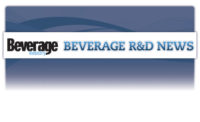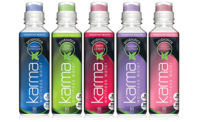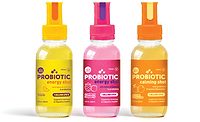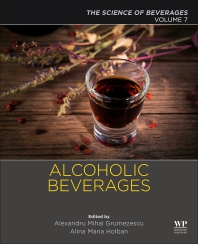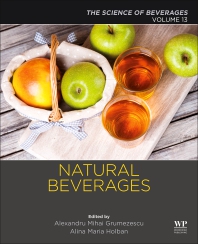Beverages combining prebiotics, probiotics
Health and wellness drives consumer interest in probiotics, prebiotics, fiber

Kombucha, and other fermented beverages, are popular options for delivering probiotics, experts note. KeVita’s new Mast Brew Kombucha line offers 4 billion colony forming units of probiotics in each 450-ml bottle. (Image courtesy of KeVita Inc.)

Enhanced waters and cold-pressed juices are increasingly adding probiotics for a value-added function, according to Imbibe’s Ilana Orlofsky. (Images courtesy of Suja Life LLC)

TIC Gum’s Jim Breckenridge notes the opportunity for use of encapsulated probiotics with prebiotic fibers in the powdered beverage market. (Image courtesy of Karma Culture LLC)



Antioxidants, prebiotics, probiotics, electrolytes, fiber — whichever attribute it is, consumers have come to expect their beverages to feature a functional aspect. As the macrotrend of better-for-you and functional beverages continues to thrive, more products are being launched that target consumers’ digestive health concerns. With a growing understanding of gut-health ingredients, experts say consumers also are gaining an interest and curiosity in the benefits of combining digestive-health ingredients.
“The megatrend of functional food and beverage has exploded,” says Ilana Orlofsky, marketing coordinator at Imbibe, Niles, Ill. “Therefore, products with fiber and probiotics are perfectly aligned with this megatrend. Currently, they’re most common in fermented beverages, like the tea-based kombucha and kefir, and enhanced waters.”
Doris Dougherty, Fibersol technical service representative at Decatur, Ill.-based Archer Daniels Midland Co. (ADM), adds that these ingredients also are common in dairy- and yogurt-based beverages. "Gut health is a very hot trend," she says. "Mintel data shows that three out of four consumers in the USA say that maintaining a healthy digestive system is 'very important' to them. And fiber continues to be one of the most recognized and sought-after ingredients for digestive health."
Although consumers are less knowledgeable about prebiotics as they are about probiotics, companies are using the combination to differentiate themselves on the marketplace, according to Patrick Luchsinger, marketing manager of nutrition at Westchester, Ill.-based Ingredion Inc. “By utilizing combinations they can produce a stronger value proposition,” he says.
Encapsulated fiber also can help aid in the survival of probiotics in the stomach, says Mar Nieto, senior principal scientist at White Marsh, Md.-based TIC Gums Inc. “Fiber, such as gum polysaccharides, are non-digestible and are able to shield the probiotics during transit in the stomach,” he says.
Jim Breckenridge, TIC Gum’s technical service representative, echoes similar sentiments. “There is a great natural symbiosis between pre- and probiotics,” he says. “Prebiotic fiber serves as an excellent food source for probiotic bacteria and helps to establish a foothold in the intestines.”
ADM's Dougherty also notes the trend saying that the two have a symbiotic relationship, as the prebiotics play an essential role in promoting the live cultures in probiotics. "The benefit is that you are not only supplying the beneficial bacteria, but you are also providing food for beneficial bacteria, either those that are being provided or those already present in someone's [gastrointestinal] GI system."
Numerous categories can capitalize on the benefits of pre- and probiotic ingredients. For example, fruit juice-, dairy-, yogurt- and tea-based beverages potentially can benefit from combining pre- and probiotics, Breckenridge says. “There is also a major opportunity for use of encapsulated probiotics with prebiotic fiber in the powdered beverage market.”
Educating consumers on these gut-health combinations and their benefits will be essential to the success and growth of the category, according to David Keller, vice president of scientific operations at Ganeden Inc., Mayfield Heights, Ohio. “While consumers have an understanding of the difference [between prebiotics and probiotics], there is definitely room for more education, especially on whether a prebiotic is needed with a probiotic,” he says. “The best thing beverage-makers can do is promote education on the specific strain of probiotic and types of prebiotics used in their beverages.
“It’s important to choose a specific strain that is science-backed and has research supporting its claims … and whether a prebiotic is beneficial,” he continues. “Companies need to make sure that there is an adequate amount of probiotics and prebiotics on the last day of the product’s shelf life to confer a benefit and support packaging claims.”
Ganeden has partnered with beverage companies to produce high-fiber beverages using its probiotic GanedenBC30, Keller says. “Consumers are looking for products where functional ingredients have been added, and [because] fiber is associated with digestive issues, putting a fiber and probiotic together makes sense,” he says.
Finding the pros
As consumers continue to learn and strive for an overall better-for-you diet, probiotics themselves have grown in demand. “[Consumers] are becoming more aware of what they’re eating and have an interest in additional health benefits in everyday foods and beverages,” Keller says. “They are continuing to look for convenient, lifestyle friendly products with additional health benefits — such as probiotic applications.”
Probiotics commonly are found in organic and natural beverages, such as kombucha, tonics and enhanced waters, according to Imbibe’s Orlofsky. “These are the categories that incorporate probiotics most frequently, though juices and sodas are gaining market share within this value-added function,” she says.
However, formulating with probiotics comes with its share of challenges. According to Ganeden’s Keller, many probiotics are unable to withstand manufacturing and beverage manufacturers should look at clinical studies for evidence of efficacy and to ensure inclusion rates. He adds that GanedenBC30 has a unique structure that allows it to make it through most of the process without the use of additional technologies.
Imbibe’s Orlofsky says that the amount of probiotics in a beverage can range and often is based on the marketing claims the brand is looking to make. “They range from hundred-millions to -billions of colony forming units, and they don’t contribute a lot of dry weight to the finished product,” she says. “Some mainstream beverages have over 4 billion probiotics. Most of the literature on doses doesn’t recommend more than 10 billion probiotics in a day to achieve overall gut health.”
A call for fiber
Consumers have gained an increasing awareness of the need for various nutrients, most notably fiber, according to Nancy Gaul, senior health and wellness category manager of global marketing at Tate & Lyle, Decatur, Ill. “We’ve seen a growing awareness of the need for fiber and the health benefits fiber provides,” she says. “As a result, consumers are more conscious of choosing food and beverage products that contain fiber. In fact, according to a 2015 IFIC study, fiber was one of the Top 3 ingredients that consumers claim they are looking to consume more of (behind whole grains and before protein).”
Yet, consumer understanding of the relationship between prebiotics and probiotics continues to be strained. “Consumer awareness of probiotics and their role in the body and the health benefits they provide is higher than the awareness of prebiotics,” Ingredion’s Luchsinger says. “… Prebiotic fibers, primarily short-chain fructo-oligosaccharides (scFOS) and galacto-oligosaccharides (GOS) are the stong prebiotics options for beverage-makers.”
Prebiotics/fiber can offer unique challenges when used in a beverage formulation, experts explain. “The first challenge is incompatibility between fiber and beverage ingredients,” TIC Gum’s Nieto says. “Gum arabic and inulin are non-viscous fiber and can be used at functional doses. However, gum arabic is not always compatible with proteins unless the pH is adjusted. Inulin can have a synergistic effect and increase viscosity of a beverage.”
TIC Gum’s Breckenridge highlights that the company offers several fiber ingredients applicable for beverage formulations, including Nutriloid Gum Arabic FT-90, TIC Pretested Inulin LV 110 Powder, a guar gum, and Konjac.
However, not all fibers offer the same functional benefits, according to Tate & Lyle’s Gaul, and this makes it essential for a manufacturer to work with its supplier to find the best fiber option.
Tate & Lyle offers Promitor Soluble Fiber, which has a higher digestive tolerance and stability in lower pH beverages, Gaul says. Also for beverages, Tate & Lyle offers PromOat Beta Glucan, which has a beta glucan content as high as 35 percent, Gaul adds.
According to Ingredion’s Luchsinger, when working with a prebiotic fiber, beverage formulators must consider solubility, pH, heat stability, texture and mouthfeel, and flavor. “Finding the right prebiotic fiber to provide you the right attributes you are looking for is critical,” he says. “In addition, the amount or dose of the prebiotic fiber [that] the formulator requires in order to make a structured function claim around digestive health should be considered.”
He notes that the company offers several prebiotic fibers available for beverage applications, including Nutraflora, a scFOs that is highly dispersible and completely soluble; Bioligo GOS, is stable in high temperatures and low-pH products; and Nutriose is a resistant destrin and prebiotic fiber that is soluble and shelf stable in high acidic/low pH applications.
In partnership with Matsutani, ADM offers Fibersol, which Dr. Steven Young of Matsutani says is heat and acid stable. "Some fibers break down under acid, temperature or shear, while Fibersol does not break down under extreme processing conditions," he explains. "Beverage manufacturers benefit because Fibersol requires minimal formulation and process adjustments. Fibersol-2 is fully compatible with all processing, packaging, distribution, storage, point-of-sale presentation and demands of delivering prebiotic benefits through the fully intended shelf-life of the beverage while maintaining the sensory appeal, as originally designed."
According to ADM's Dougherty, Fibersol contains 90 percent dietary fiber, is low in calories, while providing digestive tolerance and performing many of the functional properties of sugar. "Fibersol can perform many of the functional properties of sugar, offering formulators a real option to replace sugar and achieve caloric reduction and without a high glycemic spike and subsequent insulin response," she explains. "Fibersol can be used with minimal formulation adjustments in a variety of beverage applications to maintain or improve a product's desired attributes."
The company recently expanded its offerings with the launch of a liquid version of Fibersol: Fibersol-2L. "This new product has the same low calorie content of Fibersol-2 with 90 percent soluble dietary fiber (dsb), and is very easy for manufacturers to incorporate into beverages," Dougherty says. "And because it is liquid, Fibersol-2L allows for bulk handling and ease of incorporation, saving the manufacturer time by eliminating the need for mixing that is required when using powwder form - and without clumping that can happen with powder."
Looking for a reprint of this article?
From high-res PDFs to custom plaques, order your copy today!




